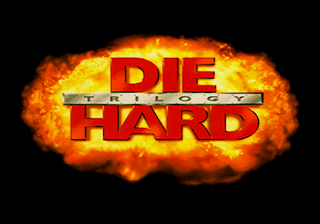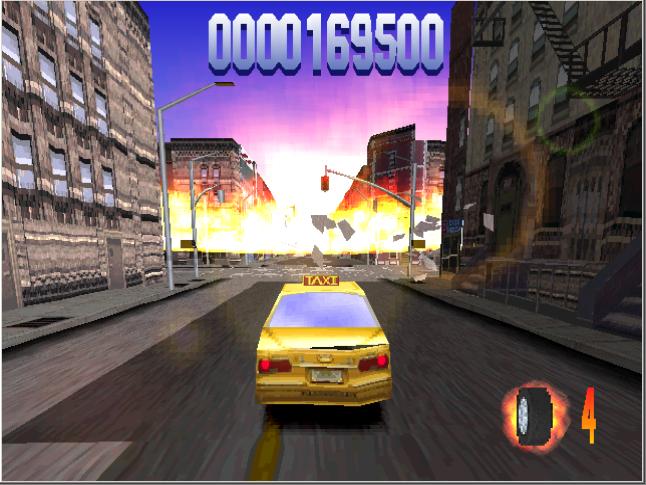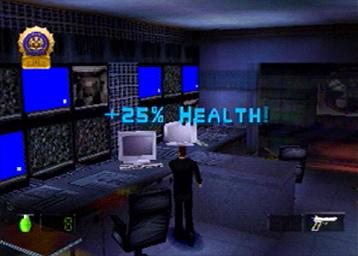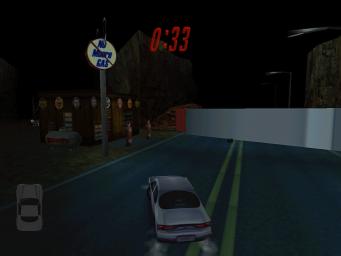Tuesday, 20 August 2013
Double Review: Die Hard Trilogies
Game: Die Hard Trilogy
Console: Sony Playstation
Developer: Fox Interactive
Release Date: 31st August 1996
The Die Hard Trilogy features 3 games, based on the first 3 movies of the Die Hard film franchise, each with a different control method. The first (Die Hard) is a 3rd person run and gun action adventure through almost maze like floors of the building from the film. The second (Die Harder) is a light gun shooter but with controller input instead of an actual lightgun, and the final game (Die Hard With A Vengeance) is a driving game where your aim is to get to certain locations in time. On the face of it the Die Hard Trilogy looks promising, and at least action packed, with 3 very different games to offer.
The first game begins in an underground car park as John McClane shoots his way through a nest of terrorists and frees hostages from their grasp. To complete the level, all of the terrorists must be shot, but the hostages are optional. You're given a radar on which terrorists show up red, and hostages show up blue which helps somewhat in locating them. There's around 20 terrorists on the first level to find, and they're quite well spread out over the level.
The draw distance on levels is pretty bad, you can hardly see 20 feet in front of you before a black shadow obscures your view. Enemies who are beyond your sight can still be shot, but they can also still shoot at you which is a pain if you've missed them on your radar. There's also weapon and health powerups hidden throughout the levels and some elements of the level are destructable. Once the floor is cleared of terrorists, John must get to the lift to deactivate the bomb, and then progress to the next level.
As the levels progress, there are more terrorists and larger areas to explore, with a total of 20 playable floors to the game. I feel this is a few too much as you're only given a couple of health wheels to start with and although there's powerups, it's fairly difficult to progress all the way. It does get points however for effort, and decent level designs. It's pretty enjoyable on the whole, and although fairly basic, it gets the job done.
The second game of the trilogy begins in an airport, and escalates fairly quickly into a massive shootout between McClane and the terrorists that seem to plague his existence. Presented in the form of a lightgun rail shooter but with only the controller to direct the action, this part plays pretty nicely with fast paced action and an enjoyable dynamic overall. With weapon and health upgrades appearing as targetable extras, there's a wider range of guns to choose from and a better opportunity to progress than the first part.
Although the game may have worked well with a light gun, it doesn't affect the gameplay too much that you're restricted to just the d-pad on the controller for your aiming. This part of the collection is by far my favourite as the movement around the level is fluid, if a little linear (as is the case with most rail shooters) and the concept is to literally shoot every bad guy you see. There's some enjoyable points where civilians have to be shot around in order to kill terrorists, and the levels are generally well planned out.
The final game of the first trilogy is so bad, its hardly worth talking about. Based loosely on a driving concept, you attempt to reach a bomb before it explodes with vague directions from a passenger. If you arrive on time (and I'm sure some of them are impossible to reach on time), you run over the bomb and it explodes but not as massively as if you didn't. I'm not quite sure what happened in the third Die Hard movie, but I'd bet that it wasn't this.
The car handles in an average manner when driving around but as soon as you hit anything, the car goes off in a random direction. Sometimes it'll continue straight on the path you were taking, and others it'll steer itself into a wall. With hardly any time to lose to begin with, hitting anything spells instant doom for your bomb reaching attempts that turn. Luckily you only get three lives so games are usually short. It seems as if they spent the least time on this part of the game, with only one level to roam around and not much to do in it.
Graphically, the game is fairly poor overall with a short draw distance in the first part and strange walking animations. There's not much to complain about in part two, save for a slight lack of detail in the surroundings. Part three looks pretty terrible in truth, up close buildings look misaligned and very pixellated. Musically, the game features a decent action soundtrack which fits what's happening on screen most of the time. The voice acting doesn't fare so well however; at one point in the first game John McClane declares "Ouch, that hurt" upon getting shot, which seems a small understatement.
The concept of having three games together on one disk was an exciting idea; three ways to experience the Die Hard franchise on the Playstation. In truth however, its pretty hard to develop and release three consistently fun and different games, on one game's time and monetary budgets. As a result, Die Hard Trilogy produces one decent shooter, an enjoyable rail shooter and a horrific driving game. Overall this makes it pretty average, unless you only play one or two portions of the game.
Rating: 66/100
Grade: C
Game: Die Hard Trilogy 2: Viva Las Vegas
Console: Sony Playstation
Developer: Fox Interactive
Release Date: 29th February 2000
Having decided to take another stab at the trilogy concept, Fox Interactive decided it'd be best to have a game that wasn't based on a Die Hard movie, but instead had a plot set in Las Vegas. In the story, John McClane gets invited to a party in Las Vegas, thrown by his friend who is a prison warden. Unfortunately there's a jail break and so John has to intervene and the game begins. We lead John through the prison, and out to chase those pesky terrorists down all over again.
The segments in the game are basically the same as in the first; the game begins with a 3rd person on foot, run and gun type game where John McClane clears out a prison of everyone inside as he makes his way to the party. In an effort to beat the prisoners and wardens there, he shoots them in the rail shooter section which makes its way out of the prison onto the open road, where we chase down a busload of terrorists and destroy some bad guys' cars.
The first section of the game is much improved with smoother control, a lot of options to get gameplay exactly how you'd like, analog stick support, and puzzle like sections where you must open the next part of the level before progressing. The levels still include destructible furniture and environments, perhaps even moreso than before and they're longer than before, but less in number. Powerups are still scattered around, and there's a lot of shooting to do, but objectives are now the main goal of these levels.
The second part of the game actually supports some light guns for use with it, but unfortunately the light gun I had wasn't compatible. The controller plays almost well enough for me not to mind this, however. With much the same idea as in the first game, my only complaint of this part is that the targeting reticles appear on the enemies crotches rather than their heads which can be offputting. This section of the game is the only one that I feel hasn't improved upon its counterpart from the first game.
The driving section of the game shows the most improvement from the original game, with the same sort of handling, but a better concept. John must now chase down and destroy enemy cars whilst tailing the bus full of terrorists which drops bombs at regular intervals. Hitting the rival cars will damage them, and there's a better radar used with this section than in the first trilogy also. While I'd say its still the weakest part of the game as a whole, it doesn't let the game down half as much as the final section of the original.
Graphically, there are major improvements from the first game with much less blockyness and pixellation. Some parts of the first section of the game were impressive for the Playstation's capabilities, especially lighting. The music is more generic than in the first game, and could be better but that's not to say that it's bad. The voice acting has improved very slightly and there's story related cutscenes between each game, if you play in Movie Mode.
Overall as a game Die Hard Trilogy 2: Viva Las Vegas improves on its predecessor in almost every aspect of its games. Graphically sharper with better gameplay to match, it does feel slightly less fast paced at times and the plot feels extremely weak, but I don't think this outweighs the fun that can be had. Unfortunately some features of the first game didn't make it over, such as the ability to shoot civilians without any penalty (save for that of your score), and weapon upgrades in the rail shooter mode. I'd say that this game just about edges ahead, in terms of quality overall, with a better last segment and the addition of new elements to the third person stage.
Rating: 71/100
Grade: C
Labels:
PS1
Subscribe to:
Post Comments (Atom)










No comments:
Post a Comment